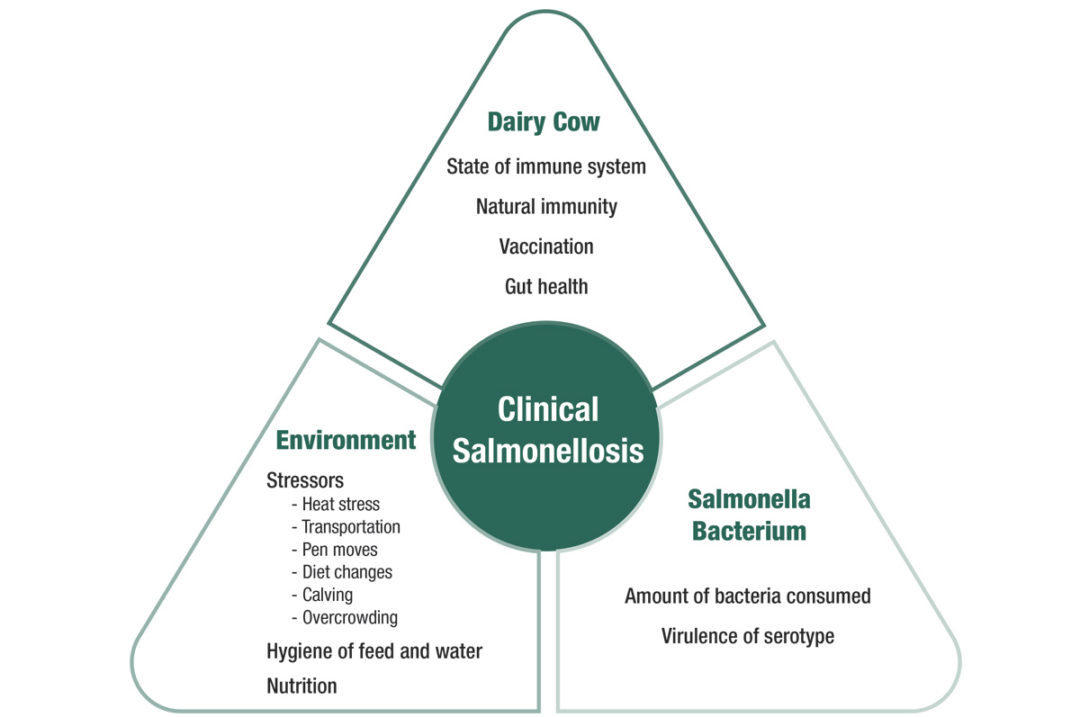Salmonella is a highly infectious and contagious, gram-negative bacterium that can hide from a cow’s immune system by living inside other cells. There are more than 2,600 different serotypes, or kinds, of salmonella in existence. Only 10-20 of them seem to cause issues in dairy cattle. Some of the most common salmonella serotypes in bovines include Salmonella Newport, S. Dublin, S. Typhimurium, S. Montevideo and S. Cerro.
Salmonella is shed in very large numbers in feces. It is most commonly spread from one cow to another through fecal-oral transmission, or in other words, when cows consume the manure of an animal that is shedding the bacteria. They usually ingest this infected manure in their feed or water. Salmonella is also shed in saliva, nasal secretions, urine, colostrum and milk from infected animals.
Salmonella is a zoonotic disease. Zoonotic diseases are diseases that can be transmitted from animals to people. Therefore, it is important to practice proper hand washing after handling or treating sick animals and not to drink raw milk from salmonella-positive farms.
What is clinical salmonellosis?
Clinical salmonellosis is the disease caused by salmonella bacteria. Any cow at any stage of lactation can develop clinical salmonellosis; however, it is most common during the transition period (a couple of weeks before calving to a couple of weeks after calving). The two hallmark symptoms of salmonellosis in adult cows are diarrhea and fever.
Cows with salmonellosis commonly (but not always) have manure that is watery, yellow in color, foul-smelling, and contains streaks of blood and chunks of fibrin. Rectal temperatures reach approximately 104°-107°F. Animals may also have decreased appetites and milk yield and are dehydrated. Cows may abort their pregnancy during the last half of gestation due to salmonellosis. The aborted fetus often appears necrotic, and the cow may develop a retained placenta. If the infection is severe enough, cows may die from salmonellosis.
Clinical salmonellosis occurs all throughout the year with cases peaking in late summer to early fall (July-October). This is because 1) the bacteria are more stable, live longer and reproduce better in the environment with warm temperatures and ample moisture, thus increasing the likelihood of exposure and infection, and 2) cows are more likely to suffer from heat stress during these months, which can alter their gastrointestinal tract physiology as well as reduce their overall immune function, which may predispose them to salmonella colonization.
‘The salmonella triangle’
The salmonella triangle consists of the three factors that come together when a cow is exposed to salmonella organisms to determine whether she develops clinical salmonellosis or not, and if she does, how sick she gets from it. These factors are the salmonella bacterium, the dairy cow and the environment in which dairy cows are housed. It is the interaction of these three factors that leads to the spectrum of clinical symptoms, morbidity and mortality we see with salmonella infections.
1. The salmonella bacterium
The two most important considerations regarding the salmonella bacterium are:
Amount of salmonella organisms consumed by the cow
The number of bacteria ingested by the cow plays a large role in determining disease development. For example, did cows consume 10 colony-forming units (CFU) of salmonella or 1 billion CFU of salmonella? The lower the amount of salmonella ingested, the less likely an animal will break with clinical salmonellosis. Preventing the contamination of feed and water with manure is the most important step we can take to minimize the amount of salmonella organisms consumed by cows.
Virulence, or pathogenicity, of the salmonella serotype ingested
The pathogenicity of the salmonella serotype(s) found on your farm helps determine the clinical symptoms you see in your cows with salmonellosis. Some serotypes of salmonella possess very potent virulence factors that allow them to efficiently penetrate the gastrointestinal tract and evade the cow’s immune system, resulting in severe disease. Other serotypes are less pathogenic and create only mild diarrhea that is sometimes confused with winter dysentery or digestive upsets.
2. The dairy cow
There are a variety of cow-specific factors that influence her susceptibility and response to salmonella bacteria. Supporting immune function and a healthy gastrointestinal tract in cows, especially transition animals, will help maximize resistance to this pathogen. These cow-specific factors include:
- The state of the cow’s immune system currently. Is she able to mount a strong immune response to this pathogen?
- Has she been exposed to this pathogen previously and developed natural immunity?
- Does she have immunity created through salmonella vaccination?
- Does she have a normal, healthy gut microbiome?
- Is she experiencing leaky gut and/or the breakdown of the tight junctions between cells of her gastrointestinal tract, thereby allowing salmonella bacteria to penetrate?
3. The environment
The environment in which we house dairy cows and our management of it play huge roles in initiating and transmitting salmonella infections, as well as determining the severity of disease. Examples of how the environment can impact clinical salmonellosis are:
Stressors
Stressors are important triggers of clinical salmonellosis. Stressors can lead to the secretion of the immunosuppressive hormone, cortisol. On dairy farms, it is usually not just one stressor that cows are exposed to but the stacking of multiple stressors that brings about clinical salmonellosis. Common stressors of dairy cattle include transportation, heat stress, overcrowding, calving, diet changes, poor cow comfort, pen moves, dry-off, commingling of animals with other parities, concurrent infections with other bacterial or viral pathogens, and recent anesthesia or surgery.
Hygiene of feed and water
The most common way salmonella is transmitted from one cow to another is through eating feed or drinking water that contains infected manure. Manure contamination of feedstuffs can occur at any point during the feeding process including loading, mixing, delivery and push-up. Preventing the contamination of feed and water with manure is key to reducing clinical salmonellosis cases. Feed and water can become contaminated with manure on dairy farms when:
- Tractor, truck or mixer wagon tires drive over the total mixed ration (TMR) in the feedbunk
- Manure on farm workers’ boots is deposited in the TMR while standing in the feedbunk to treat animals
- Manure from crossover alleys in freestall barns is pushed up into the TMR
- Cows defecate in waterers and feedbunks
- Manure on blades or tires of feed pushers is deposited in the TMR during push-ups
- Birds and rodents defecate on forages and/or stored commodities in the feed center or on the TMR in the feedbunk
Nutrition
Nutrition plays a pivotal role in overall dairy cow health and performance. Therefore, it is no surprise that nutrition can also impact clinical salmonellosis cases. Vitamins and trace minerals must be fed at proper concentrations to support normal immune function. To promote optimal gut health, diets should contain adequate physically effective fiber as high-concentrate rations can lead to increased shedding of gram-negative bacteria in feces. Starch may also bypass the rumen and lead to hindgut fermentation and acidosis, which damages the gastrointestinal tract, thereby allowing salmonella colonization.
The development of appropriate, practical and effective measures to help control and/or prevent clinical salmonellosis can be accomplished through minimizing cow exposure to the bacteria and maximizing cow resistance. This requires assessment of all three factors of the salmonella triangle and their interactions with each other.
Strategies for prevention, management and control of clinical salmonellosis
- Prevent contamination of feed with manure. Designate equipment that is used to handle feed only. Clean the tires, buckets and blades of this equipment often. Place silage bags on solid surfaces to minimize contamination. Reduce water runoff through silage piles and bunkers. Scrape the center of the feed alley at least once per day. Control bird and rodent populations. Adult cow refusals fed to youngstock can serve as a source of infection if it is contaminated with salmonella organisms.
- Keep waterers clean and clear. Cows with clinical salmonellosis shed bacteria in their saliva, contaminating waterers while drinking. Animals may also defecate into waterers. Waterers should be cleaned multiple times per week to decrease bacterial numbers.
- Make maternity pen hygiene a priority. Salmonella is commonly shed in feces around the time of parturition. Contaminated maternity pens serve as an important source of infection for calves.
- Identify and correct management and environmental stressors, especially in transition cow pens that might impair immune function and trigger clinical salmonellosis. Pay particular attention to abating heat stress through the use of shade, fans and sprinklers.
- Consider vaccinating your herd against salmonellosis. Vaccinating an adult cow can help protect both her and her calf through the transfer of maternal antibodies in colostrum. Timing of vaccine administration should be based on protecting cows during their most vulnerable stage, the transition period, as well as for colostrogenesis. Commercially available, USDA-licensed vaccines, as well as custom-made autogenous vaccines, are options for salmonella immunization. Dairy producers should work with their veterinarians to determine if vaccination might be right for their herd. Recommendations should be based on your herd’s health history and salmonella risk factors.
- Support a healthy gastrointestinal tract and gut microbiome. Feeding appropriate amounts of a well-balanced diet, using consistent ingredients that are properly mixed and delivered to cows, will help maintain a healthy gastrointestinal tract and minimize the risk of clinical salmonellosis. Disruptions in the gut microbiome can enhance salmonella colonization. There are a variety of feed additives that are marketed to help support gut health during salmonella challenges. Dairy producers should discuss these options with their nutritional consultants and veterinarians.
- Disinfect all equipment used to treat or haul sick and/or dead animals, including halters, nose tongs, balling guns, esophageal feeders, boots and trailers.
- Implement effective fly control. A recent study showed that flies from 79% of surveyed farms carried salmonella organisms on their legs, feet and other body parts. Flies that feed on cattle manure can play a critical role in spreading salmonella on dairies.







